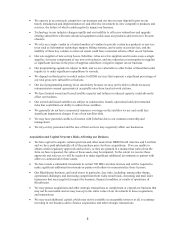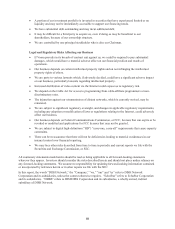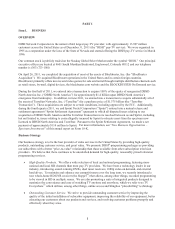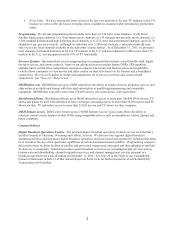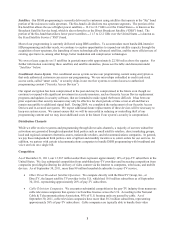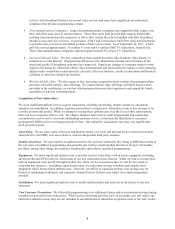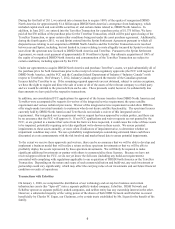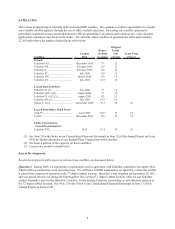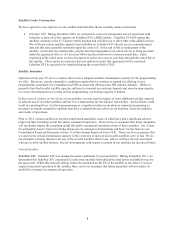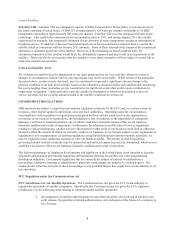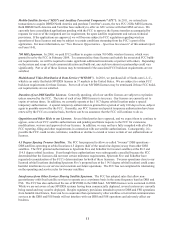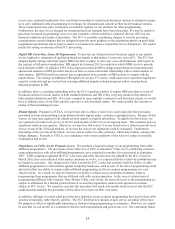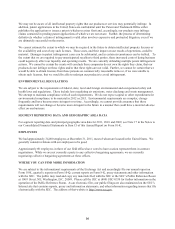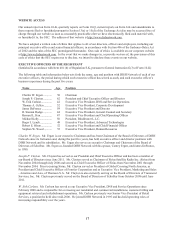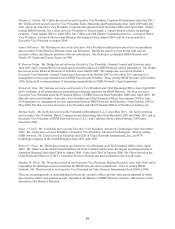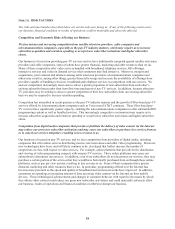Dish Network 2011 Annual Report Download - page 19
Download and view the complete annual report
Please find page 19 of the 2011 Dish Network annual report below. You can navigate through the pages in the report by either clicking on the pages listed below, or by using the keyword search tool below to find specific information within the annual report.9
9
Leased Satellites
EchoStar VIII. EchoStar VIII was designed to operate 32 DBS transponders with the ability to provide service to
the entire continental United States (“CONUS”) at approximately 120 watts per channel, switchable to 16 DBS
transponders operating at approximately 240 watts per channel. EchoStar VIII was also designed with spot-beam
technology. This satellite has experienced several anomalies prior to 2011, and during January 2011 the satellite
experienced an anomaly, that temporarily disrupted electrical power to some components causing an interruption of
broadcast service. In addition, it has now been determined one of the two on-board computers used to control the
satellite failed in connection with the January 2011 anomaly. None of these anomalies has impacted the commercial
operation or estimated useful life of the satellite. However, if the remaining on-board computer fails, the
commercial operation of the satellite would likely be substantially impacted and may result in an impairment of the
satellite. There can also be no assurance that this anomaly or any future anomalies will not reduce its useful life or
impact its commercial operation.
Long-Lived Satellite Assets
We evaluate our satellite fleet for impairment as one asset group and test for recoverability whenever events or
changes in circumstances indicate that its carrying amount may not be recoverable. While certain of the anomalies
discussed above, and previously disclosed, may be considered to represent a significant adverse change in the
physical condition of an individual satellite, based on the redundancy designed within each satellite and considering
the asset grouping, these anomalies are not considered to be significant events that would require evaluation for
impairment recognition. Unless and until a specific satellite is abandoned or otherwise determined to have no
service potential, the net carrying amount related to the satellite would not be written off.
GOVERNMENT REGULATIONS
DBS operators are subject to significant government regulation, primarily by the FCC and, to a certain extent, by
Congress, other federal agencies and foreign, state and local authorities. Depending upon the circumstances,
noncompliance with legislation or regulations promulgated by these entities could result in the suspension or
revocation of our licenses or registrations, the termination or loss of contracts or the imposition of contractual
damages, civil fines or criminal penalties, any of which could have a material adverse effect on our business,
financial condition and results of operations. Furthermore, the adoption or modification of laws or regulations
relating to video programming, satellite services, the Internet or other areas of our business could limit or otherwise
adversely affect the manner in which we currently conduct our business. If we become subject to new regulations or
legislation or new interpretations of existing regulations or legislation that govern Internet network neutrality, we
may be required to incur additional expenses or alter our business model. The manner in which legislation
governing Internet network neutrality may be interpreted and enforced cannot be precisely determined, which in turn
could have an adverse effect on our business, financial condition and results of operations.
The following summary of regulatory developments and legislation in the United States is not intended to describe
all present and proposed government regulation and legislation affecting the satellite and video programming
distribution industries. Government regulations that are currently the subject of judicial or administrative
proceedings, legislative hearings or administrative proposals could change our industry to varying degrees. We
cannot predict either the outcome of these proceedings or any potential impact they might have on the industry or on
our operations.
FCC Regulation under the Communications Act
FCC Jurisdiction over our Satellite Operations. The Communications Act gives the FCC broad authority to
regulate the operations of satellite companies. Specifically, the Communications Act gives the FCC regulatory
jurisdiction over the following areas relating to communications satellite operations:
x the assignment of satellite radio frequencies and orbital locations, the licensing of satellites and
earth stations, the granting of related authorizations, and evaluation of the fitness of a company to
be a licensee;


